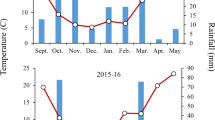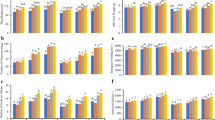Abstract
Canola (Brassica napus L.) oil yield and fatty acid composition are the function of genotype, climate conditions, morphology, and physiology as well as crop management. In this study, the reaction of different canola cultivars—in terms of seed oil content and fatty acids—to different planting dates and foliar zinc application during two experimental years (2016–2017) was investigated in the field in arid and semi-arid regions of Karaj, Iran. The experiment was performed as a factorial split plot in a randomized complete-block design with three replications. Three sowing dates (February 9, 19, 29) and two foliar zinc applications (non-application as control and zinc application; spraying in the stem elongation stage) were factorially randomized to main plots, and canola cultivars (Sarigol, Dalgan, Salsa, and Solar) were allocated to sub-plots. The results indicated that the effect of year, planting date, zinc application, cultivar, and the interaction effect of planting date and cultivar on quality traits (glucosinolate and fatty acids) and seed yield were significant (p < 0.01). The delay in winter planting of spring canola cultivars caused a significant reduction in seed yield, oil yield, and the content of oleic, linoleic, and palmitic fatty acids and increased the content of linolenic, erucic, stearic, arachidic, and behenic fatty acids and glucosinolate. The highest seed yield (4732.2 kg/ha), oil yield (2066 kg/ha), and oleic acid content (66.52%) were observed in the Dalgan cultivar in the zinc application treatment with normal planting date (February 9). The Salsa cultivar had the highest content of erucic acid (0.46%) and glucosinolate (17.3 μmol/g meal) in the control treatment with the last planting date. Because the quality of edible canola oil depends on the increase in unsaturated fatty acids, particularly oleic and linoleic acids, and the reduction of erucic acid and glucosinolate, planting Dalgan cultivar with zinc application at the normal planting date is recommended for the study area and similar areas.
Zusammenfassung
Der Ölertrag und die Fettsäurezusammensetzung von Raps (Brassica napus L.) hängen vom Genotyp, den klimatischen Bedingungen, der Morphologie und Physiologie sowie dem Pflanzenbau ab. In dieser Studie wurde die Reaktion verschiedener Rapssorten in Bezug auf den Samenölgehalt und die Fettsäuren auf verschiedene Pflanztermine und die Blattapplikation von Zink in 2 Versuchsjahren (2016–2017) auf dem Feld in ariden und semiariden Regionen von Karaj, Iran, untersucht. Der Versuch wurde als faktorieller Split-Plot in einem randomisierten vollständigen Blockversuch mit 3 Wiederholungen durchgeführt. Faktoriell wurden 3 Aussaattermine (9. Februar, 19. Februar und 29. Februar) und 2 Zink-Blattanwendungen (Nichtanwendung als Kontrolle und Zinkanwendung; Spritzen im Stadium der Stängelstreckung) zum Haupt-Plot, und die Rapssorten (Sarigol, Dalgan, Salsa und Solar) wurden den Split-Plots zugeordnet. Die Ergebnisse zeigten, dass die Auswirkungen des Jahres, des Pflanzdatums, der Zinkanwendung, der Sorte und des Interaktionseffekts von Pflanzdatum und Sorte auf die Qualitätsmerkmale (Glucosinolat und Fettsäuren) und den Samenertrag signifikant waren (p < 0,01). Die Verzögerung der Winteraussaat von Sommerraps führte zu einer signifikanten Verringerung des Samenertrags, des Ölertrags und des Gehalts an den Fettsäuren Ölsäure, Linolsäure und Palmitinsäure und erhöhte den Gehalt an Linolensäure, Erucasäure, Stearinsäure, Arachidinsäure, Behensäure und Glucosinolat. Der höchste Saatgutertrag (4732,2 kg/ha), der höchste Ölertrag (2066 kg/ha) und der höchste Ölsäuregehalt (66,52 %) wurden bei der Sorte Dalgan bei normalem Pflanztermin (9. Februar) bei der Behandlung mit Zink beobachtet. Die Sorte Salsa wies den höchsten Gehalt an Erucasäure (0,46 %) und Glucosinolat (17,3 μmol/g Mehl) in der Kontrollbehandlung am letzten Pflanztermin auf. Da die Qualität von Rapsspeiseöl von der Erhöhung der ungesättigten Fettsäuren, insbesondere von Ölsäure und Linolsäure, und der Verringerung von Erucasäure und Glucosinolat abhängt, wird der Anbau der Sorte Dalgan mit Zinkanwendung zum normalen Pflanztermin für das Untersuchungsgebiet und ähnliche Gebiete empfohlen.





Similar content being viewed by others
References
Afsahi K, Nazari M, Omidi H, Shekari F, Bostani AA (2020) The effects of different methods of zinc application on canola seed yield and oil content. J of Plant Nutrition. https://doi.org/10.1080/01904167.2020.1724299
Alipour ZM, Darikvand MB (2020) Evaluation of traits affecting yield and components of yield in different cultivars of Canola under cold climate conditions. Int J Pharm Res Allied Sci 9(3):41–45
Arifuzzaman M, Rahman M (2020) Genome wide association mapping and candidate gene mining for root architectural traits in rapeseed/canola (Brassica napus L.) at late growth stage. Euphytica 216:164. https://doi.org/10.1007/s10681-020-02700-z
Brown PH, Bellaloui N, Wimmer MA, Bassil ES, Ruiz J, Hu H, Pfeffer H, Dannel F, Römheld V (2002) Boron in plant biology. Plant Biol 4:205–223
Burton WA, Ripley VL, Potts DA, Salisbury PA (2004) Assessment of genetic diversity in selected breeding lines and cultivars of canola quality Brassica juncea and their implications for canola breeding. Euphytica 136:181–192
Bybordi A, Mamedov G (2010) Evaluation of application methods efficiency of zinc and iron for canola (Brassica napus L.). Notulae Sci Biol 2(1):21–30
Cakmak I (2008) Enrichment of cereal grains with zinc: agronomic or genetic biofortification. Plant Soil 302:1–17
Codex (1999) Codex standard for named vegetable oils. CODEX-STAN 210-1999, pp 1–16
Davoudi A, Mirshekari B, Shirani-Rad AH, Farahvash F, Rashidi V (2016) Investigate the effect of selenium application on quantity and quality of oil yield in canola cultivars under delayed planting conditions. Crop Physiol J 8(31):131–145
Dirwai TL, Senzanje A, Mabhaudhi T (2021) Calibration and evaluation of the FAO aquacrop model for Canola (brassica napus) under varied moistube irrigation regimes. Agriculture 11(5):410
Doori S, Moradi Telavat MR, Siadat SA, Bakhshandeh A (2015) Effect of delayed planting and foliar application of nitrogen on canola seed and oil yield in Ahvaz conditions. Iran J Crop Sci 17(2):128–138
Flakelar CL, Luckett DJ, Howitt JA, Dorana G, Prenzler PD (2015) Canola (Brassica napus) oil from Australian cultivars shows promising levels of tocopherols and carotenoids, along with good oxidative stability. J Food Compos Anal 42:179–186
Gecgel U, Demirci M, Esendal E, Tasan M (2007) Fatty acid composition of the oil from developing seeds of different cultivars of safflower (Carthamus tinctorius L.). J Am Oil Chem Soc 84:47–54
Habibi M, Majedeian M, Rabei M (2014) The effect of boron, zinc and sulfur on grain yield and fatty acid composition of rapeseed oil. J Agric Agric 16(1):69–84
Hassan MU, Aamer M, Chattha MU, Haiying T, Shahzad B, Barbanti L, Nawaz M, Rasheed A, Afzal A, Liu Y, Guoqin H (2020) The critical role of zinc in plants racing the drought stress. Agriculture 10:396
IRIMO (2016) Iranian meteorological office data processing center. Islamic Republic of Iran Meteorological Office,
ISO-5511:(1992. 1998). Oilseeds-Determination of oil content-method using continuous-wave low-resolution nuclear magnetic resonance spectrometry (Rapid method). Geneva: International Organization for Standardization.
Jasinska Z (1987) The influence of sowing dates and sowing rates on the development and yield of winter rape varieties. Proc. 7th Int. Rapeseed Cong. Poznan, Poland, pp 886–892
Kalantar Ahmadi SA, Shoushi Dezfouli AA (2019) Effects of foliar application of micronutrients on seed yield and oil quality of canola (Brassica napus L. cv. Hyola401) under drought stress conditions. Iran J Crop Sci 21(3):237–253 (In Persian)
Keshavarz H (2020) Study of water deficit conditions and beneficial microbes on the oil quality and agronomic traits of canola (Brassica napus L.). Grasas Aceites 71(3):373
Koscielny CB, Gardner SW, Duncan RW (2018) Impact of high temperature on heterosis and general combining ability in spring canola (Brassica napus L.). Field Crop Res 221:61–70
Lee D, Noh B, Bae S, Kim K (1988) Characterization of fatty acids composition in vegetable oils by gas chromatography and chemometrics. Anal Chim Acta 358:163175
Metcalf LD, Schmitz AA, Pelka JR (1966) Rapid preparation of fatty acid esters from lipids for gas chromatographic analysis. Anal Chem 38:514
Molazem D, Azimi J, Dideban T (2013) Measuring the yield and its components, in the Canola in different planting date and plant density of the west Guilan. Int J Agric Crop Sci 6(12):869–872
Nasr N, Khayami M, Heidary R, Jameie R (2006) Genetic diversity among selected varieties of Brassica napus (Cruciferea) based on biochemical composition of seeds. J Sci Technol Agric Nat Resour 32(1):37–40
Nazeri P, Shirani Rad AHS, ValadAbadi A, Mirakhori M, Masoule HE (2019) The effect of planting date and late season drought stress on Eco-physiological characteristics of the new varieties of Canola (Brassica napus L.). J Agroecol 11(1):261–276 (In Farsi)
Samadzadeh Ghale Joughi E, Majidi Hervan E, Shirani Rad AH, Noormohamadi GH (2018) Fatty acid composition of oilseed rapeseed genotypes as affected by vermicompost application and different thermal regimes. Agron Res 16(1):230242
Sattar A, Cheema MA, Wahid MA, Saleem MF, Ghaffari M, Hussain Sh, Arshad M (2013) Effect of sowing time on seed yield and oil contents of Canola varieties. J Glob Innov Agric Soc Sci 1(1):1–4
Sharafi Y, Majidi MM, Goli SAH, Rashidi F (2015) Oil content and fatty acids composition in Brassica species. Int J Food Prop 18:2145–2154
Shirani Rad AM (2012) The study of agronomical traits of spring rapeseed cultivars in the condition of different plantings dates (Karaj region in Iran). Ann Biol Res 3(9):4546–4550
Shoja T, Majidian M, Rabiee M (2018) Effects of zinc, boron and sulfur on grain yield, activity of some antioxidant enzymes and fatty acid composition of rapeseed (brassica napus L.). Acta Agric Slovenica 111:73–84
Siadat SA, Hemayati SS (2009) Effect of sowing date on yield and yield components of three oilseed rape varieties. Plant Ecophysiol 1:31–35
Sieling K, Böttcher U, Kage H (2017) Sowing date and N application effects on tape root and above ground dry matter of winter oilseed rape in autumn. Eur J Agric 83:40–46
Soleymani A, Moradi M, Naranjani L (2011) Effects of the irrigation cut-off time in different growth stages on grain and oil yield components of autumn’s Canola Cultivars in Isfahan region. J Water Soil 25(3):426–435 (In Persian)
Tang L, Hamid Y, Liu D, Shohag MJI, Zehra A, Hee Z, Fenga Y, Yang X (2020) Foliar application of zinc and selenium alleviates cadmium and lead toxicity of water spinach—bioavailability/cytotoxicity study with human cell lines. Environ Int 145:106122
Thies W (1974) New methods for the analysis of rapeseed constituents. Proceeding. of the 4th Rapeseed Congress, Giessen, pp 275–282
Tsonev T, Lidon FJC (2012) Zinc in plants—An overview. Emirates J Food Agric 24:322–333
Turhan H, Kemal V, Egese V, Kahriman V (2011) Effect of sowing time on grain yield, oil content and fatty acids in rapeseed (Brassica napus subsp. oleifera). Turk J Agric 35:225–234
Valipour Dastenaei M, Shirani Rad AH, Valadabadi SA, Seifzadeh S, Zakeri HR (2020) Effect of Winter Planting Date on Qualitative Traits and Yield of Spring Rapeseed (Brassica napus L.) Cultivars by Using Zinc Spray in Karaj Region. J Crop Ecophysiol 13(4):589–604 (In Persian)
Wynne K, Neely CB, Adams C, Kimura E, DeLaune PB, Hathcoat D, Gerrish B (2020) Testing row spacing and planting rate for fall-planted spring canola in the southern United States. Agron J 112:1952–1962
Acknowledgements
The authors would like to thank the Department of Oil Crops, Seed and Plant Improvement Institute, Agricultural Research, Education and Extension Organization (AREEO), Iran, for providing the facilities to conduct this research.
Author information
Authors and Affiliations
Corresponding author
Ethics declarations
Conflict of interest
H. Mozafari, A. Shirani Rad, E. Jalili, B. Sani, and F. Rajabzadeh declare that they have no competing interests.
Rights and permissions
About this article
Cite this article
Mozafari, H., Shirani Rad, A., Jalili, E. et al. Effect of Winter Planting Date on Oil Yield and Fatty Acids of New Spring Canola (Brassica napus L.) Cultivars Under Foliar Zinc Spray. Gesunde Pflanzen 74, 435–446 (2022). https://doi.org/10.1007/s10343-021-00620-z
Received:
Accepted:
Published:
Issue Date:
DOI: https://doi.org/10.1007/s10343-021-00620-z




